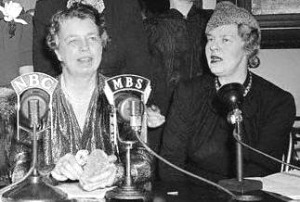Eleanor Roosevelt with Dorothy Thompson in 1942
New York, N.Y.
Dorothy Thompson house
237 East 48th Street
Dorothy Thompson (1894-1961), one of the most intrepid foreign correspondents of her day and the author of I Saw Hitler, was once married to writer Sinclair Lewis, but the great love of her life was Christa Winsloe, author of the novel upon which the classic lesbian film Mädchen in Uniform was based. After the break with both of them, Thompson lived alone in this three-story brownstone in the Turtle Bay neighborhood of Manhattan from 1941 to 1957. She spent more than $20,000 for renovations to make it, as she wrote, “the most perfect small house I have ever seen.”
Thompson’s “small” home included a library with more than 3,000 books, five fireplaces, and a third-floor study for writing. In the drawing room, a wine-colored satin sofa could hold, she bragged, five of “the most distinguished bottoms in New York.” When the renovations were complete, Thompson invited a reporter from Look magazine to inspect the final product, and he remarked admiringly on the many telephones, intercoms, and labor-saving devices throughout the house.
In the front door were eight painted glass panels showing Thompson in medieval attire performing various tasks – writing, lecturing, greeting guests. There was also the house’s motto: “Gallus in sterquilinio suo plurimum potest.” (“The rooster on his own dunghill is very much in charge.”) New York’s Historic Landmark Preservation Center placed a medallion on Thompson’s brownstone in 1995.


You must be logged in to post a comment.